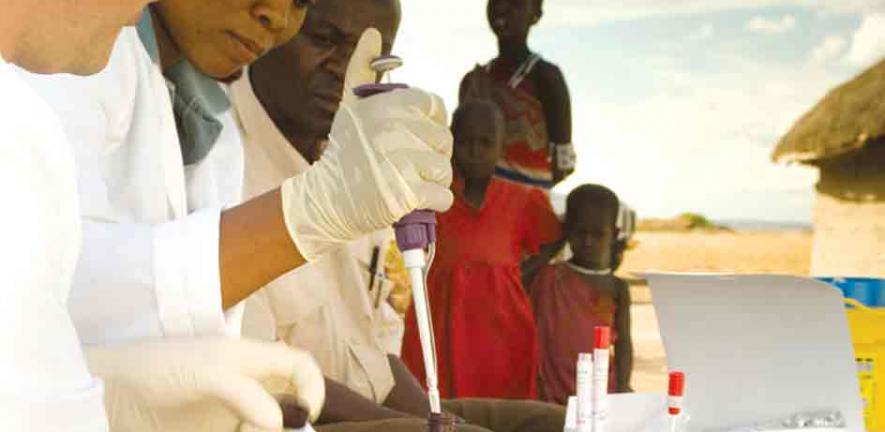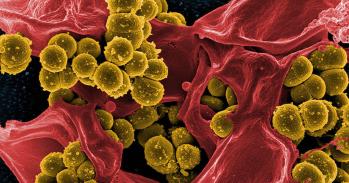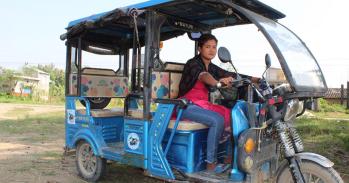
A new test meets the diagnostic needs of resource-poor settings in both worlds.
A new test meets the diagnostic needs of resource-poor settings in both worlds.
Several diseases have been targeted by the DDU, including chlamydia, paediatric HIV infection and hepatitis B, all of which are prevalent in the poorer regions of the world.
A new ‘dipstick’ test meets the diagnostic needs of resource-poor settings in both worlds.
New generations of diagnostic tests are continually being developed for the benefit of people living in affluent nations, but the diagnostic needs of those in the poorest parts of the world, who also have the highest burden of infection, are inadequately met. The lack of resources and skilled labour has contributed to the seemingly unstoppable spread of some diseases.
At the Diagnostics Development Unit (DDU) in the Department of Haematology, the goal of Dr Helen Lee and co-workers is to deliver diagnostic tests that are rapid, intuitively simple, excellent in performance and low in production cost for the detection of infectious agents that affect the millions living in resource-poor settings.
The fruit of innovation
Several diseases have been targeted by the DDU, including chlamydia, paediatric HIV infection and hepatitis B, all of which are prevalent in the poorer regions of the world. Dr Lee’s group has developed an inexpensive, sensitive and easy-to-use ‘dipstick’ test that detects a bacteria called Chlamydia trachomatis, based on a sensitive visual amplification detection technology the group has developed and patented. The Chlamydia bacteria cause trachoma, an eye infection spread by the Bazaar fly or through lack of hygiene. An estimated 84 million people are afflicted by trachoma, 90% of whom live in the developing world. The disease has led to blindness in 1.3 million and visual impairment in 7 million people. Chlamydia is also the cause of the most commonly diagnosed sexually transmitted bacterial infection in the UK, and the leading cause of infertility in women. Once diagnosed, both infections can be easily cleared by a single dose of antibiotics.
In a trial involving over 600 Masai children in Tanzania, the trachoma test proved to be more than twice as effective in detecting disease than traditional analysis. Claude Michel, the scientist who developed the trachoma dipstick test said: ‘It was fantastic to be able to show the children, there and then, what we had found. If a steady purple line appeared on the dipstick, it indicated that they were infected and we could treat them immediately.’ Speed of testing and treatment is crucial – it means children don’t have to make the long and arduous journeys back to the testing site for treatment and it circumvents difficulties in locating those infected. In Africa, where there is just one ophthalmologist for every million people, a simple and accurate test will increase identification of infected individuals.
Dr Silvio P. Mariotti, head of the WHO Alliance for the Global Elimination of Trachoma by 2020, referred to the dipstick test as ‘a very promising and interesting tool’ that will ‘bridge one of the biggest limitations of infection detection through laboratory means, which is that you need very complicated sampling methodology.’
The future
Meeting the diagnostic needs of the developing world cannot be achieved in a sustainable way by altruistic efforts alone. To commercialise the technologies, a spinout company – Diagnostics for the Real World – has been set up near San Francisco. The company has two-tiered pricing: charging premium price in developed countries and at near-manufacturing cost in developing countries. Having successfully completed the UK clinical trials of the Chlamydia dipstick for the diagnosis of genital infections, the test recently received regulatory approval for use in European countries. Both dipstick tests will have a major health impact worldwide and meet a convergence of needs that can be summed up as ‘two worlds, same needs, one solution’.
For more information, please contact the author Dr Helen Lee (hl207@cam.ac.uk) at the Diagnostics Development Unit, Department of Haematology.
This work is licensed under a Creative Commons Licence. If you use this content on your site please link back to this page.





